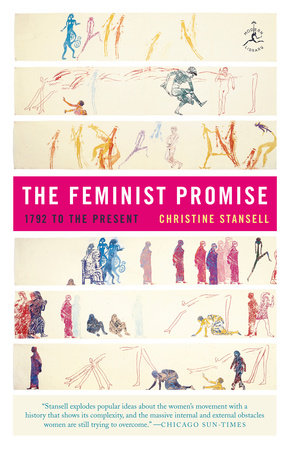The Feminist Promise
1792 to the Present
Christine Stansell
Paperback
May 10, 2011 | ISBN 9780812972023
AmazonBarnes & NobleBooks A MillionBookshop.orgHudson BooksellersPowell'sTargetWalmart
Ebook
May 11, 2010 | ISBN 9781588369161
AmazonApple BooksBarnes & NobleBooks A MillionGoogle Play StoreKobo
About the Book
“A unique, elegant, learned sweep through more than two centuries of women’s efforts to overcome the most fundamental way that human beings have been wrongly divided into the leaders and the led. It’s full of surprises from the past and guiding lights for the future.”—Gloria Steinem
For more than two centuries, the ranks of feminists have included dreamy idealists and conscientious reformers, erotic rebels and angry housewives, dazzling writers, shrewd political strategists, and thwarted workingwomen. Well-known leaders are sketched from new angles by Stansell, with her bracing eye for character: Mary Wollstonecraft, the passionate English writer who in 1792 published the first full-scale argument for the rights of women; Elizabeth Cady Stanton, brilliant and fearless; the imperious, quarrelsome Betty Friedan. But figures from other contexts, too, appear in an unforgettable new light, including Ruth Bader Ginsburg, who in the 1970s led a revolution in the constitutional interpretations of women’s rights, and Toni Morrison, whose bittersweet prose gave voice to the modern black female experience.
Stansell accounts for the failures of feminism as well as the successes. She notes significant moments in the struggle for gender equality, such as the emergence in the early 1900s of the dashing “New Woman”; the passing of the Nineteenth Amendment, which granted women the right to vote; the post–World War II collapse of suburban neo-Victorianism; and the radical feminism of the 1960s—all of which led to vast changes in American culture and society. The Feminist Promise dramatically updates our understanding of feminism, taking the story through the age of Reagan and into the era of international feminist movements that have swept the globe. Stansell provocatively insists that the fight for women’s rights in developing countries “cannot be separated from democracy’s survival.”
A soaring work unprecedented in scope, historical depth, and literary appeal, The Feminist Promise is bound to become an authoritative source on this essential subject for decades to come on. At once a work of scholarship, political observation, and personal reflection, it is a book that speaks to the demands and challenges—individual, national, and international—of the twenty-first century.
For more than two centuries, the ranks of feminists have included dreamy idealists and conscientious reformers, erotic rebels and angry housewives, dazzling writers, shrewd political strategists, and thwarted workingwomen. Well-known leaders are sketched from new angles by Stansell, with her bracing eye for character: Mary Wollstonecraft, the passionate English writer who in 1792 published the first full-scale argument for the rights of women; Elizabeth Cady Stanton, brilliant and fearless; the imperious, quarrelsome Betty Friedan. But figures from other contexts, too, appear in an unforgettable new light, including Ruth Bader Ginsburg, who in the 1970s led a revolution in the constitutional interpretations of women’s rights, and Toni Morrison, whose bittersweet prose gave voice to the modern black female experience.
Stansell accounts for the failures of feminism as well as the successes. She notes significant moments in the struggle for gender equality, such as the emergence in the early 1900s of the dashing “New Woman”; the passing of the Nineteenth Amendment, which granted women the right to vote; the post–World War II collapse of suburban neo-Victorianism; and the radical feminism of the 1960s—all of which led to vast changes in American culture and society. The Feminist Promise dramatically updates our understanding of feminism, taking the story through the age of Reagan and into the era of international feminist movements that have swept the globe. Stansell provocatively insists that the fight for women’s rights in developing countries “cannot be separated from democracy’s survival.”
A soaring work unprecedented in scope, historical depth, and literary appeal, The Feminist Promise is bound to become an authoritative source on this essential subject for decades to come on. At once a work of scholarship, political observation, and personal reflection, it is a book that speaks to the demands and challenges—individual, national, and international—of the twenty-first century.
Read more
Close




